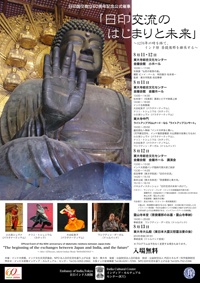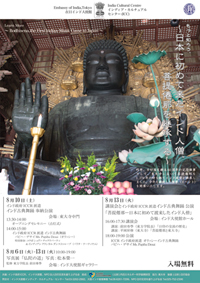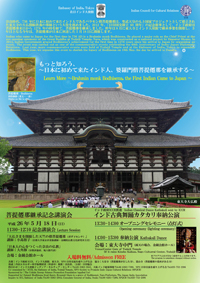 |
菩提僊那継承の事業が今年も開催されました |
菩提僊那は記録史上、日本に初めて来たインド人であり、開眼導師をつとめた功績は大きなものです。2012年、インド政府は日印国交樹立60周年の記念催事として、菩提僊那を1276年の時を経て継承しました。その後も毎年、インド大使館や東大寺にて開催して参りました。4年目となる今年も、菩提僊那が太宰府に到着した5月18日に開催いたしました。国際化の時代、継承事業を続ける中で、インド人の顔をした菩提僊那像をという声があがり、インド大使館の協力のもと、インドで制作された菩提僊那像が今年の4月、日本に到着しました。
|
| もっと知ろう、 〜日本に初めて来たインド人、婆羅門僧菩提僊那を継承する〜 Learn More ~Brahmin monk Bodhisena, the First Indian Came to Japan ~ |
|
|
| 【ディーパ・ゴパラン・ワドワ駐日インド大使のご挨拶 】
菩提僊那継承催事を毎年主催なさってきた日印交流を盛り上げる会の皆様にお祝いを申し上げ、感謝いたします。またご支援をいただきました大安寺、霊山寺、日印協会、奈良県庁の皆様に御礼申し上げます。この催事を成功させるため多大なご尽力をいただいたすべての皆様に感謝申し上げます。 今年の継承催事は二つの理由でたいへん特別なものとなっています。一つには、この催事が現在継続中の「日本におけるインド祭」の一環として 行われていること、二つめは、今年インドで制作された菩提僊那像がこの特別な機会のため奈良に届けられていることです。この継承催事に関わっている私たち全員にとって、これは誇らしいことです。 このような行事は、今の世代に、日印両国を結びつけている文化的な絆と繋がりについて情報を発信する絶好の機会となります。若い人たちにこれらのことについて伝え、関わりを促していくことが大切です。そうすれば、われわれ両国が共有する偉大な歴史的遺産の記憶が受け継がれて行くからです。 第4回菩提僊那継承事業2015(於:奈良・東大寺2015年5月18日)における |
| [English] Message of Smt. Deepa Gopalan Wadhwa Ambassador, Embassy of India, Tokyo at the event to commemorate Bodhisena May 18, 2015, at Todaiji Temple, Nara
|
| 【菩提僊那像製作に寄せて】 印度と日本の繋がりは、かの国に誕生した仏教がわが国に伝来したことに始まります。そして、その伝来からおよそ二百年を経た奈良時代、天平八年(736)に一人の天竺国(印度)の僧が第九次遣唐使船で来日しました。婆羅門僧正とも、また菩提僧正とも称され、人々から敬われた菩提僊那(ボーディ・セーナ Bodhisena)です。 この印度の僧侶である菩提僊那の名を広く知らしめたのは、天平勝宝四年(752)、聖武帝の誓願により、東大寺に盧舎那仏(大仏)が造立され、その開眼供養が営まれた時、僧正が像内に魂を請じ入れるための儀式で開眼の筆を執ったことによります。それは仏教を興した釈尊誕生の地から遥々来日された僧による開眼として、大きな意義を持つものでした。僧正が握った大仏開眼の筆には、およそ200メートルにおよぶ縹色の縷(る)が結ばれ、多くの人々がこれに結縁し、そのゆかりの品々は今も正倉院宝物として大切に伝えられています。 お釈迦様の誕生の地であり、仏教発祥の国から訪れた僧侶が我が国の大仏の開眼を行ったことは、東アジアの仏教文化圏において、極めて歴史的な意義をもつ出来事でした。 爾来、東大寺では天平の草創に関わった、本願聖武上皇(観世音菩薩の化身)、開山良弁僧正(弥勒菩薩の化身)、勧進聖行基上人(文殊菩薩の化身)、そして開眼師菩提僊那(普賢菩薩の化身)という四聖の一人として、かの僧正の御影を掲げています。 その御影は早く『先徳図像』(平安時代 12世紀、旧高山寺蔵、現東京国立博物館蔵)や『三国祖師影』(鎌倉時代 14世紀、醍醐寺蔵)といった白描図像に認められますが、聖武天皇五百年遠忌にあたる建長九年(1257)に四聖講会の本尊として製作された東大寺蔵『四聖御影』(建長本/鎌倉時代、絹本著色、重要文化財、旧四聖坊什物、現東大寺蔵)の彩色画に結実しています。そして、さらに南北朝時代の永和三年(1377)に建長本を模写した(永和本/南北朝時代、絹本著色、重要文化財、旧眉間寺什物、現東大寺蔵)が製作されました。この永和本を元にわが国では近代に至り、様々な節目に菩提僊那像の製作が行われ、現在三体の尊像が僧正ゆかりの東大寺、霊山寺、大安寺の南都(奈良)の三寺に安置されています。 来日した僧正が難波の浦から奈良の都へ至る道すがらの富雄で、聖地霊鷲山に似ていることを喜び、後にその菩提が弔われた地とされる霊山寺の尊像(善本秀作氏製作、楠木彫一木彫り白木地仕上げ)は、昭和六十年(1985)に東山光師貫主により開眼されました。また、東大寺の尊像(上原美千代氏製作、木彫、篠崎悠美子氏彩色)は、大仏開眼千二百五十年慶讃法要に臨んで平成十四年(2002)に橋本聖圓別当により大仏殿の広庭で開眼されました。近くは、僧正が止住していた大安寺において、千二百五十年の御遠忌と平城遷都千三百年とが重なる平成二十二年(2010)にその御影(宮本道夫氏製作、彩色、軸装)が河野良文貫主によって開眼されました。 菩提僊那については、これまでわが国においては『東大寺縁起絵詞』や『大仏縁起絵巻』をはじめとする多くの説話などの伝承世界が語り継ぎ、また上記の僧正像や御影の製作をもって温(あたた)められてきたという歴史的経緯があります。そうしたなかで、このたびのインド大使館協力による菩提僊那像の製作は、平成24年(2012)、日印(にちいん)の国交樹立60周年を迎え、また翌年が日印協会創立110周年でもあったという節目に、東大寺で菩提僊那継承事業を公式催事として行ない、その後も毎年開催する中、日印両国側からインド人の顔をした尊像製作の機運が芽生え、高まったことによります。 インド、デリーにある3D像の専門、ASTRO LINKS による製作にあたっては、イメージ作りの参考として、『四聖御影』をもとに、『先徳図像』や『三国祖師影』、加えて東寺(とうじ)に所蔵される『真言七祖像』の「龍猛像」(弘仁十二年(821) 平安時代、絹本著色、空海製作企図)など、また老いを加える意味で「俊乗房重源上人座像」(鎌倉時代、木彫)を日本側から提示しました。 折しも、インド政府が日本で開催中の「インド祭 2014−2015」の主要催事、東京国立博物館特別展「コルカタ・インド博物館所蔵 インドの仏 仏教美術の源流」というインドの仏教美術が紹介される時節、日印交流の賜物として造像された菩提僊那像に多くの方々が出遇われることを通し、僧正来日の歴史的な意義が知られるとともに、本像が、未来へ向け、仏教はもとより、広く日印両国の様々な分野における交流の懸け橋となりますことを、ここに心より願っております。 平成27年(2015)4月 |
[English]On the Production of Bodhisena’s StatueThe tie between India and Japan started when Buddhism reached Japan from India. Some 200 years later from the arrival of Buddhism to Japan, a monk from Tenjiku (India) came to Japan in 736, on board the nineth Japanese missions to Tang China. This monk was Bodhisena who was also called Baramon Sojo or Bodai Sojo. He was highly repspected by poeple. Bodhisena became widely known when he performed a critical role in the eye-opening ceremony for a new statue of the Buddha Vairocana (or Great Buddha) at Todaiji Temple in 752. The eye-opening ceremony is considered to be very important ritual because it is believed that by painting eyes of Buddha statue, one can invite the holly spirit into it. Bodhisena was specially requested by the Emperor Shomu to be the master of the ceremony. The ceremony perfromed by a monk, who came from the land of Buddha, bore great significance. The paintbrush Bodhisena held had many light-blue strings attached to it. The length of strings were as long as 200 meters. Monks and attendees of the ceremony held the other end of them so that they could have the blessing from the Lord Buddha. Items used in the ceremony have been passed down as important tresures for generations and are kept at Shosoin today. It was indeed meaningful for the monk, who came from the birth place of Buddha and Buddhism, to have conducted the eye-opening ceremony in Japan, in terms of the history of Buddhist culture in East Asia. Since then, an image of Bodhisena has been enshrined at the Todaiji Temple as one of four saints who made great contribution in the early days of the temple. Four great saints of the Todaiji Temple are the Promoter, Emperor Shomu (an avator of Avalokitesrava Bodhisattva), the Temple Founder, Rev. Roben Sojo (an avator of Maitreya), the Fund-Raiser, Rev. Gyoki Shonin (an avator of Manjuusri), and the Eye-Opener, Bodhisena (an avator of Samantabhadra). The early images of Bodhisena drew. Prominent One of the temples is Ryosenji Temple where Bodhisena is said to have been buried. Ryosenji Temple is located in a mountain which Bodhisena found very similar to the Vulture Peak or Gijjhakuta in India. When Bodhisena was traveling from Naniwanoura to Nara, he passed a place called Tomio. There, he was pleased to see a mountain that reminded him of the Vulture Peak or Gijjhakuta in India. The temple has a statue of Bodhisena which was curved out of one camphor tree by Mr. Shusaku Yoshimoto. The eye-opening ceremony was conducted in 1985 by the Chief Abbot of the temple, Rev. Koshi Toyama. Todaiji Temple has another wooden statue of Bodhisena. This one is curved by Ms. Michiyo Uehara and colored by Ms. Yumiko Shinozaki. In 2002, an eye-opening ceremony was performed by the temple’s intendant, Rev. Shoen Hashimoto, in a garden in front of the Colossal Hall of the Great Buddha, commemorating the 1250th Anniversary of the Eye-Opening Ceremony of the Great Buddha of Nara. Most recently, another image of Bodhisena was created in 2010 when Daianji Temple, where Bodisena used to live, celebrated the 1250th anniversary of his demise and the 1300th anniversary of the transfer of the imperial capital to Heijyokyo. The image was painted on a screen roll by Mr. Michio Miyamoto. The eye-opening ceremony was conducted by the Chief Abbot, Rev. Ryobun Kono. Bodhisena’s legacy and contributions have been passed down generations in forms of folklores, such as “Todaiji Engi Ekotoba” or “the Beginning of Todaiji Temple” and “Daibutsu Engi Emaki” or “the Beginning of the Great Buddha of Nara”. And his images also have been developed throughout the history by the creation of afore mentioned statues and paintings. In such background, it was decided to create a statue of Bodhisena this year with cooperation of Embassy of India, Tokyo. The momentum to create the statue of Bodhisena, which bears more facial characteristics of an Indian, started to rise when an official event to celebrate him was held at Todaiji Temple for the first time in 2012. This event later was made into an annual event. The year 2012 also was a milestone year for the Japan-India relationship and for the Japan-India Association. Japan and India celebrated the 60th anniversary of diplomatic relations in 2012 and JIA celebrated the 110th anniversary from its establishment in the same year. Upon the creation of Bodhisena’s statue by India’s Astoro rinks, a 3D image expert, Japan side provided the company with various images of Bodhisena such as “Shishono Mie”, “Sentokuzuzo”, “Sangoku Soshiei”, and “Ryumyouzo” (821 AD, Heian Era, color on silk, designed by Kukai) which is a part of “Shingon Shichisozo” or “Seven Founders of Shingon Sect”, Toji Temple, Kyoto). Moreover, we provided an image of “A Seated Wooden Statue of Shunjobo Chogen Shonin”(a statue of Japanese monk, Kamakura Era, Wood, Todaiji Temple) as a reference to show how a monk may look when he ages. Currently, a special exhibition called “Indian Buddhist Art from Indian Museum, Kolkata”, which is the most important event of Festival of India 2014-2015, is being held at the Tokyo National Museum. The exhibition introduces some of the finest pieces of India’s Buddhist arts and the most recent image of Bodhisena. The 3D image of Bodhisena is a fruit of a long and amicable relationship between Japan and India. On this special occasion, I sincerely hope Bodhisena’s statue may enlighten many people of the historical significance of his visit to Japan. Also, it is my sincere hope that this statue may serve as a bridge to further promote Japan-India exchanges at various levels as well as Buddhism. May, 2015 Concurrently Lecturer, Gakushuin University |
【過去の菩提僊那継承事業】 |
【日本に於けるインド祭2014-2015】【奉納公演:Shri Delhi R. Sridhar南インド古典音楽公演南インド古典音楽】 |
(c) Copyright 1996/2015 Mithila Museum. All rights reserveds


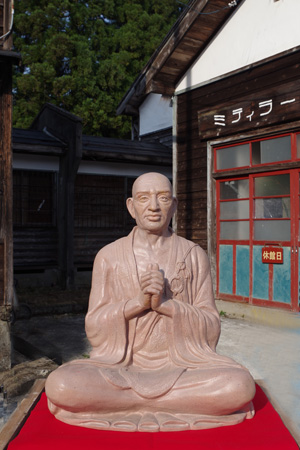 【菩提僊那像制作の経緯 】
【菩提僊那像制作の経緯 】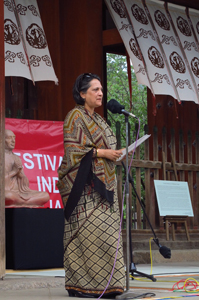 今日ここで皆様とともにインド人仏僧・菩提僊那の1279年前の来日を記念する継承催事に参加するため、ここ奈良に来ることが出来、大変嬉しく感じております。 菩提僊那が日本に着いてから仏教は日本で花開き、インドと日本を結ぶ大切な絆となりました。この継承催事のため、私たちは印日国交樹立60周年の2012年より、インド人アーティストによる公演を東大寺で開催してきました。
今日ここで皆様とともにインド人仏僧・菩提僊那の1279年前の来日を記念する継承催事に参加するため、ここ奈良に来ることが出来、大変嬉しく感じております。 菩提僊那が日本に着いてから仏教は日本で花開き、インドと日本を結ぶ大切な絆となりました。この継承催事のため、私たちは印日国交樹立60周年の2012年より、インド人アーティストによる公演を東大寺で開催してきました。 